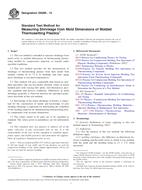We need your consent to use the individual data so that you can see information about your interests, among other things. Click "OK" to give your consent.
ASTM D6289-13
Standard Test Method for Measuring Shrinkage from Mold Dimensions of Molded Thermosetting Plastics
STANDARD published on 1.4.2013
The information about the standard:
Designation standards: ASTM D6289-13
Note: WITHDRAWN
Publication date standards: 1.4.2013
SKU: NS-34537
The number of pages: 4
Approximate weight : 12 g (0.03 lbs)
Country: American technical standard
Category: Technical standards ASTM
The category - similar standards:
Annotation of standard text ASTM D6289-13 :
Keywords:
molding shrinkage, post-molding shrinkage, thermoset plastics, ICS Number Code 83.080.10 (Thermosetting materials)
Additional information
| Significance and Use | ||||||||||||||
|
4.1 Compression Molding—In compression molding, the difference between the dimensions of a mold and of the molded article produced therein from a given material vary according to the design and operation of the mold. It is probable that shrinkage will approach a minimum where design and operation are such that a maximum of material is forced solidly into the mold cavity or some part of it, or where the molded article is hardened to a maximum while still under pressure, particularly by cooling. In contrast, shrinkages are higher where the charge must flow in the mold cavity but does not receive and transmit enough pressure to be forced firmly into all its recesses, or where the molded article is not fully hardened when discharged. The plasticity of the material used affects shrinkage insofar as it affects the retention and compression of the charge. 4.2 Injection Molding—In injection molding, as in compression molding, the differences between the dimensions of the mold and of the molded article produced therein from a given material vary according to the design and operation of the mold. The differences vary with the type and size of molding machine, the thickness of molded sections, the degree and direction of flow or movement of material in the mold, the size of the nozzle, sprue, runner, and gate, the cycle on which the machine is operated, the temperature of the mold, and the length of time that follow-up pressure is maintained. As in the case of compression molding, shrinkages will approach a minimum where design and operation are such that a maximum of material is forced solidly into the mold cavity and where the molded article is hardened to a maximum while still under pressure as a result of the use of a runner, sprue, and nozzle of proper size, along with proper dwell. As in compression molding, shrinkages are higher where the charge must flow in the mold cavity but does not receive and transmit enough pressure to be forced firmly into all of the recesses of the mold. The plasticity of the material used affects shrinkage indirectly, in that the more readily plasticized material will require a lower molding temperature. 4.3 Transfer Molding—In transfer molding, as in compression or injection molding, the difference between the dimensions of the mold and of the molded article produced therein from a given material vary according to the design and operation of the mold. It is affected by the size and temperature of the pot or cylinder and the pressure on it, as well as on mold temperature and molding cycle. Direction of flow is not as important a factor. 4.4 Materials Standards—Always refer to material standards for special treatment prior to molding, molding conditions and special handling of the test specimens after molding. In the event the material standard is unavailable, contact the manufacturer for these recommendations. 4.5 Utility—Measurement of batch-to-batch consistency in initial shrinkage from mold to molded dimensions is useful for evaluating the quality of thermosetting plastics. |
||||||||||||||
| 1. Scope | ||||||||||||||
|
1.1 This test method is intended to measure shrinkage from mold cavity to molded dimensions of thermosetting plastics when molded by compression, injection, or transfer under specified conditions. 1.2 This test method provides for the measurement of shrinkage of thermosetting plastics from their molds both initially (within 16 to 72 h of molding) and after aging (post–shrinkage at elevated temperatures). 1.3 This method will give comparable data based on standard specimens and can not predict absolute values in actual molded parts with varying flow paths, wall thicknesses, pressure gradiants and process conditions. Differences in mold shrinkage generally is observed between the specimen geometries described in this test method. 1.4 Knowledge of the initial shrinkage of plastics is important for the construction of molds and knowledge of post molding shrinkage is important for determining the suitability of the molding material for manufacturing thermosetting plastic components with accurate dimensions. 1.5 The values stated in SI units are to be regarded as standard. The values given in parentheses are for information only. 1.6 This standard does not purport to address all of the safety concerns, if any, associated with its use. It is the responsibility of the user of this standard to establish appropriate safety and health practices and determine the applicability of regulatory limitations prior to use.
|
|
Standard Practice for Compression Molding Test Specimens of Thermosetting Molding Compounds
|
|
Standard Practice for Conducting an Interlaboratory Study to Determine the Precision of a Test Method
|
|
Practice for Compression Molding Test Specimens of Phenolic Molding Compounds (Withdrawn 1992)
|
|
Standard Practice for In-Line Screw-Injection Molding Test Specimens From Thermosetting Compounds
|
|
Standard Practice for Conditioning Plastics for Testing
|
|
Standard Practice for Transfer Molding Test Specimens of Thermosetting Compounds
|
|
Standard Terminology Relating to Plastics |
Similar standards:
Historical
1.6.2011
Historical
1.5.2010
Historical
1.11.2013
Historical
1.11.2013
Historical
15.11.2012
Historical
1.4.2008
We recommend:
Updating of laws
Do you want to be sure about the validity of used regulations?
We offer you a solution so that you could use valid and updated legislative regulations.
Would you like to get more information? Look at this page.



 ASTM D6902-04(2011)..
ASTM D6902-04(2011).. ASTM D731-10
ASTM D731-10 ASTM D7426-08(2013)..
ASTM D7426-08(2013).. ASTM D7487-13
ASTM D7487-13 ASTM D7750-12
ASTM D7750-12 ASTM E1090-08
ASTM E1090-08
 Cookies
Cookies
